Photochemical Oxidation of Dimethyl Sulfide with Triplet Nitro Compounds
- Autores: Zelentsov S.V.1, Ovsyannikov D.V.1, Pyslaru A.1
-
Afiliações:
- Lobachevsky National Research University of Nizhny Novgorod
- Edição: Volume 57, Nº 4 (2023)
- Páginas: 271-275
- Seção: ФОТОХИМИЯ
- URL: https://journals.rcsi.science/0023-1193/article/view/139987
- DOI: https://doi.org/10.31857/S0023119323040162
- EDN: https://elibrary.ru/QOBYZE
- ID: 139987
Citar
Texto integral
Resumo
The mechanism of oxygen atom transfer between triplet molecules of a nitro compound and dimethyl sulfide is considered. This reaction pathway can be one of the possible routes in the reaction of photochemical oxidation of the sulfur compound. Quantum-chemical modeling has shown the feasibility of such a reaction as having a fairly low activation energy. The transition states of the reaction have almost the same structure in various solvents. The calculation of spin densities and charges on atoms in transition states has
shown no significant charge separation. This finding is also confirmed by calculation of the activation parameters of the oxygen transfer reaction involving various solvents. The activation energies remain almost unchanged with an increase in the solvent permittivity. All the data obtained suggest the radical mechanism of oxygen atom transfer with the participation of the triplet nitro compound.
Palavras-chave
Sobre autores
S. Zelentsov
Lobachevsky National Research University of Nizhny Novgorod
Email: ovsyannikov@chem.unn.ru
Nizhny Novgorod, 603022 Russia
D. Ovsyannikov
Lobachevsky National Research University of Nizhny Novgorod
Email: ovsyannikov@chem.unn.ru
Nizhny Novgorod, 603022 Russia
A. Pyslaru
Lobachevsky National Research University of Nizhny Novgorod
Autor responsável pela correspondência
Email: ovsyannikov@chem.unn.ru
Nizhny Novgorod, 603022 Russia
Bibliografia
- Hurley R., Testa A.C. // JACS. 1968. T. 90. № 8. C. 1949
- Adachi S., Kohguchi H., Suzuki T. // The Journal of Physical Chemistry Letters. 2018. T. 9. № 2. C. 270.
- Овсянников Д.В., Зеленцов С.В. // Химия высоких энергий. 2018. Т. 52. № 3. С. 199.
- Овсянников Д.В., Зеленцов С.В. // Химия высоких энергий. 2019. Т. 53. № 2. С. 95.
- Фомичев Д.А., Овсянников Д.В., Зеленцов С.В. // Химия высоких энергий. 2020. Т. 54. № 4. С. 277.
- Sako M., Shimada K., Hirota K., Maki Y. // J. Am. Chem. Soc. 1986. T. 108. № 19. C. 6039.
- Noble M., Qian C.X.W., Reisler H., Wittig C. // J. Chem. Phys. 1986. T. 85. № 10. C. 5763.
- Toniolo A., Persico M. // J. Chem. Phys. 2001. T. 115. № 4. C. 1817.
- Sarkar R., Loos P.-F., Boggio-Pasqua M., Jacquemin D. // J. Chem. Theory Comput. 2022. T. 18. № 4. C. 2418.
- Musaev D.G., Geletii Y.V., Hill C.L. // J. Phys. Chem. A. 2003. T. 107. № 30. C. 5862.
- Clarke J.L., Kastrati I., Johnston L.J., Thatcher G.R.J. // Can. J. Chem. 2006. T. 84. C. 709.
- Kulbir Das S., Devi T., Goswami M., Yenuganti M., Bhardwaj P., Ghosh S., Sahoo S.C., Kumar P. // Chem. Sci. 2021. T. 12. C. 10605.
- Neese F., Wennmohs F., Becker U. et al. // J. Chem. Phys. 2020. T. 152. C. 224108.
- Суперкомпьютер ННГУ “Лобачевский”: http://hpc-education.unn.ru/ru/ресурсы
- The PyMOL Molecular Graphics System, Version 2.0 Schrödinger, LLC.










